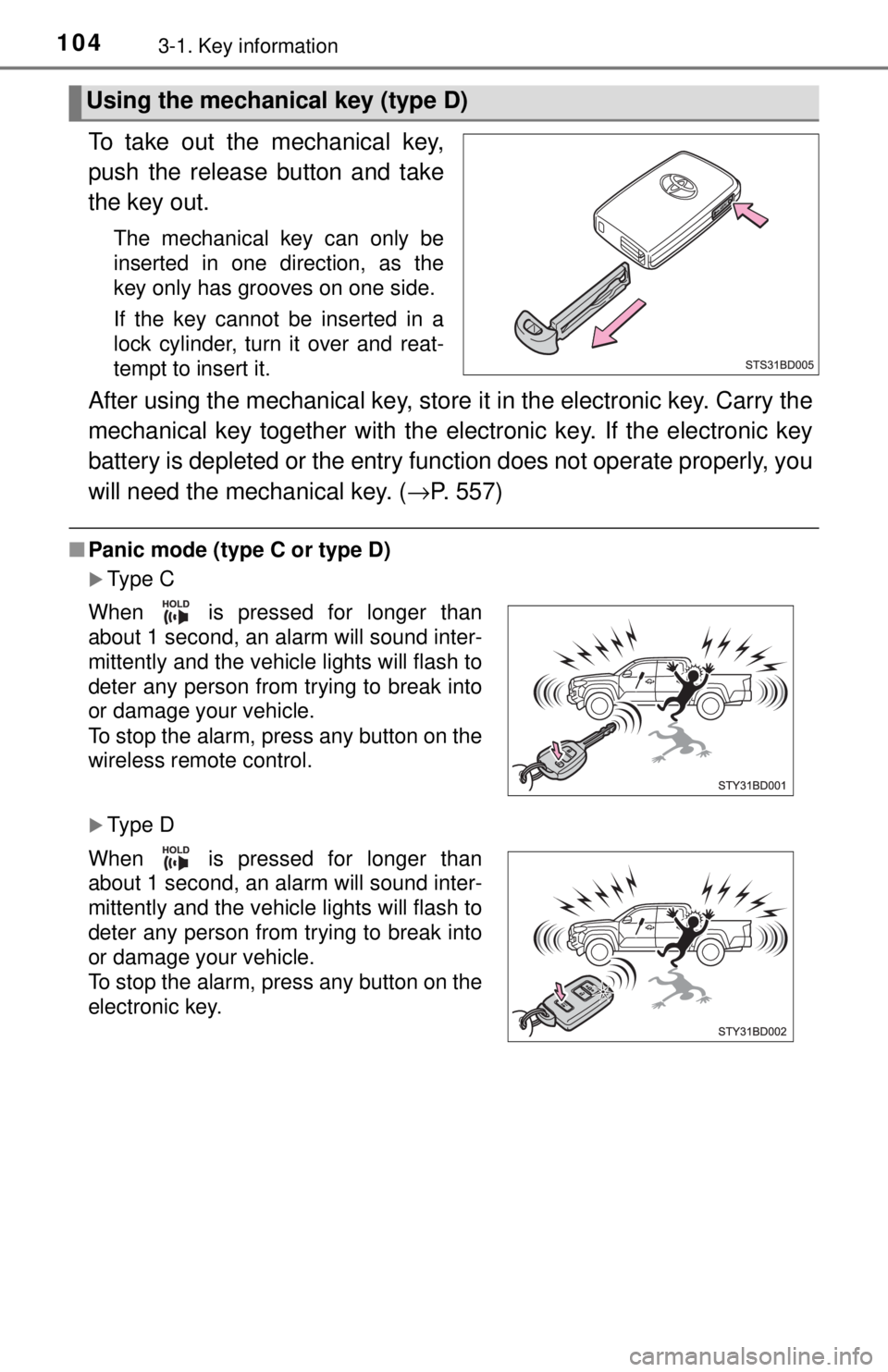Page 2 of 640

TABLE OF CONTENTS2
For your information....................... 8
Reading this manual .................... 12
How to search .............................. 13
Pictorial index .............................. 14
1-1. For safe useBefore driving ...................... 24
For safety drive ................... 26
Seat belts ............................ 28
SRS airbags ........................ 34
Front passenger occupant classification system ......... 45
Safety information for children ........................ 50
Child restraint systems ........ 51
Installing child restraints ...... 55
Exhaust gas precautions ..... 68
1-2. Theft deterrent system Engine immobilizer system............................... 69
Alarm ................................... 78
2. Instrument cluster Warning lights and indicators........................... 82
Gauges and meters............. 88
Multi-information display ..... 93
Fuel consumption information ........................ 98 3-1. Key information
Keys................................... 102
3-2. Opening, closing and locking the doors
Doors ................................. 109
Tailgate .............................. 116
Smart key system .............. 121
3-3. Adjusting the seats Front seats......................... 129
Rear seats ......................... 131
Head restraints .................. 134
3-4. Adjusting the steering wheel and mirrors
Steering wheel ................... 138
Inside rear view mirror ....... 140
Outside rear view mirrors ............................. 143
3-5. Opening, closing the windows and moon roof
Power windows.................. 145
Back window (vehicles with sliding type) .............. 148
Power back window ........... 149
Moon roof .......................... 151
1For safety and security
2Instrument cluster
3Operation of
each component
Page 23 of 640
23
For safety and security1
1-1. For safe useBefore driving ...................... 24
For safety drive ................... 26
Seat belts ............................ 28
SRS airbags ........................ 34
Front passenger occupant classification system ......... 45
Safety information for children ........................ 50
Child restraint systems........ 51
Installing child restraints...... 55
Exhaust gas precautions..... 68
1-2. Theft deterrent system Engine immobilizer system .............................. 69
Alarm................................... 78
Page 78 of 640

781-2. Theft deterrent system
Alarm∗
The alarm uses light and sound to give an alert when an intrusion is
detected.
The alarm is triggered in the following situations when the alarm is
set:
●A locked door is unlocked or opened in any way other than using
the entry function, wireless remote control or mechanical key. (The
doors will lock again automatically.)
● The hood is opened.
Close the doors and hood, and
lock all the doors. The system will
be set automatically after 30 sec-
onds.
The indicator light changes from
being on to flashing when the sys-
tem is set.
Do one of the following to d eactivate or stop the alarms:
● Unlock the doors.
● Vehicles without a smart key system:
Turn the engine switch to the “ACC” or “ON” position, or start the
engine. (The alarm will be deactivated or stopped after a few sec-
onds.)
Vehicles with a smart key system:
Turn the engine switch to ACCESSORY or IGNITION ON mode, or
start the engine. (The alarm will be deactivated or stopped after a
few seconds.)
∗: If equipped
The alarm
Setting the alarm system
Deactivating or stopping the alarm
Page 79 of 640
791-2. Theft deterrent system
1
For safety and security
■System maintenance
The vehicle has a maintenance-free type alarm system.
■ Items to check before locking the vehicle
To prevent unexpected triggering of the alarm and vehicle theft, make sure of
the following:
●Nobody is in the vehicle.
● The windows and moon roof (if equipped) are closed before the alarm is set.
● No valuables or other personal items are left in the vehicle.
■ Triggering of the alarm
The alarm may be triggered in the following situations:
(Stopping the alarm deactivates the alarm system.)
●A person inside the vehicle opens a door
or hood, or unlocks the vehicle using an
inside lock button.
● The battery is recharged or replaced
when the vehicle is locked.
Page 80 of 640
801-2. Theft deterrent system
■Alarm-operated door lock
In the following cases, depending on the situation, the door may automatically
lock to prevent improper entry into the vehicle:
●When a person remaining in the vehicle locks the door and the alarm is acti-
vated.
● While the alarm is activated, a person remaining in the vehicle unlocks the
door.
● When recharging or replacing the battery.
NOTICE
■To ensure the system operates correctly
Do not modify or remove the system. If modified or removed, the proper
operation of the system cannot be guaranteed.
Page 103 of 640
1033-1. Key information
3
Operation of each component
Ty p e D
Electronic keys• Operating the smart key sys- tem
(→P. 121)
• Operating the wireless
remote control function
Mechanical keys
Key
Key number plate
Ty p e C
Locks all the doors ( →P. 109)
Unlocks all the doors ( →P. 109)
Pressing the button unlocks the
driver’s door. Pressing the button
again within 3 seconds unlocks the
other doors.
Sounds the alarm (press and
hold) ( →P. 104)
Ty p e D
Locks all the doors ( →P. 1 1 0 )
Unlocks all the doors ( →P. 1 1 0 )
Pressing the button unlocks the
driver’s door. Pressing the button
again within 3 seconds unlocks the
other doors.
Sounds the alarm (press and
hold) ( →P. 104)
1
2
3
4
Wireless remote control (type C or type D)
1
2
3
1
2
3
Page 104 of 640

1043-1. Key information
To take out the mechanical key,
push the release button and take
the key out.
The mechanical key can only be
inserted in one direction, as the
key only has grooves on one side.
If the key cannot be inserted in a
lock cylinder, turn it over and reat-
tempt to insert it.
After using the mechanical key, store it in the electronic key. Carry the
mechanical key together with the electronic key. If the electronic key
battery is depleted or the entry func tion does not operate properly, you
will need the mechanical key. ( →P. 557)
■Panic mode (type C or type D)
Type C
Type D
Using the mechanical key (type D)
When is pressed for longer than
about 1 second, an alarm will sound inter-
mittently and the vehicle lights will flash to
deter any person from trying to break into
or damage your vehicle.
To stop the alarm, press any button on the
wireless remote control.
When is pressed for longer than
about 1 second, an alarm will sound inter-
mittently and the vehicle lights will flash to
deter any person from trying to break into
or damage your vehicle.
To stop the alarm, press any button on the
electronic key.
Page 106 of 640

1063-1. Key information
■Key battery depletion (type C or type D)
Type C
If the wireless remote control function does not operate, the battery may be
depleted. Replace the battery when necessary. (→ P. 485)
Type D
● The standard battery life is 1 to 2 years.
● If the battery becomes low, an alarm will sound in the cabin when the engine
stops. ( →P. 537)
● As the electronic key always receives radio waves, the battery will become
depleted even if the electronic key is not used. The following symptoms indi-
cate that the electronic key battery may be depleted. Replace the battery
when necessary. ( →P. 485)
• The smart key system or the wireless remote control does not operate.
• The detection area becomes smaller.
• The LED indicator on the key surface does not turn on.
● To avoid serious deterioration, do not leave the electronic key within 1 m
(3 ft.) of the following electrical appliances that produce a magnetic field\
:
•TVs
• Personal computers
• Cellular phones, cordless phones and battery chargers
• Recharging cellular phones or cordless phones
• Table lamps
• Induction cookers
■ Replacing the battery (type C or type D)
→P. 485
■ Confirmation of the registered key number
The number of keys already registered to the vehicle can be confirmed. Ask
your Toyota dealer for details.
■ Customization (type C or type D)
Settings (e.g. wireless remote control system) can be changed.
(Customizable features: →P. 595)